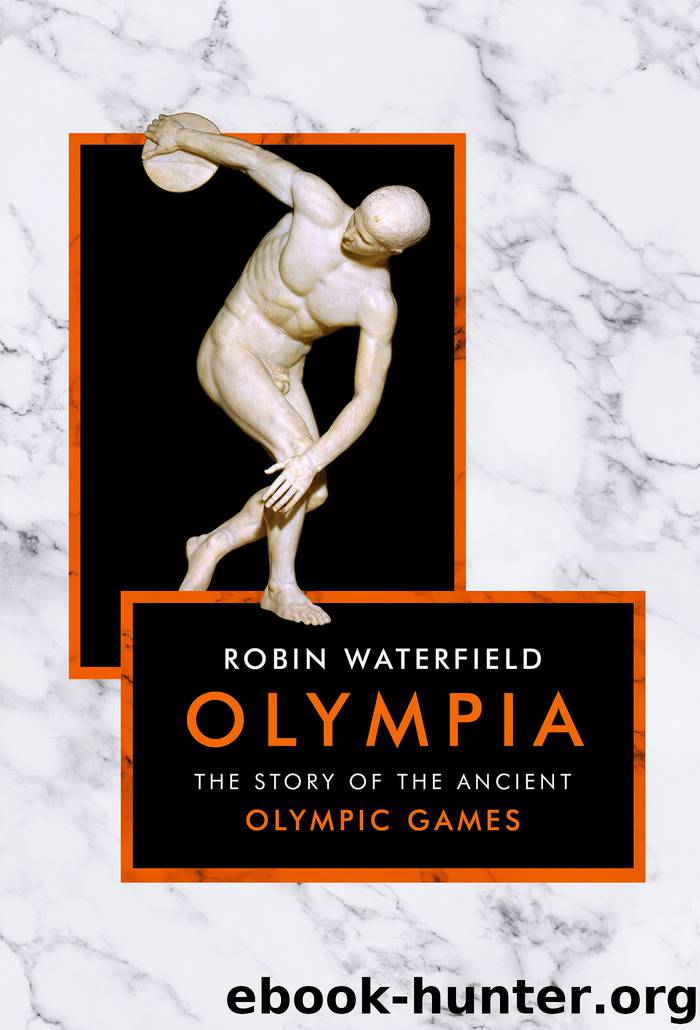Olympia by Waterfield Robin;

Author:Waterfield, Robin; [Waterfield, Robin]
Language: eng
Format: epub
Publisher: Head of Zeus
the pentathlon
The next event, occupying the afternoon of the second day, was the pentathlon, the ‘five-fold contest’. The order in which the five events were contested was probably discus, jump, javelin, sprint and wrestling (saving the toughest for last). Since it combined both heavy and light disciplines, the pentathlon was commonly held to be the best all-round test of physical fitness, and was praised as such by philosophers as well as physicians. Aristotle, for instance, said: ‘For a young man, beauty is having a body that is apt for the exertions involved in foot races and feats of strength, while he himself is pleasing for others to look upon and enjoy; this is why pentathletes are especially beautiful, because they are naturally suited for both strength and speed.’5 The first three events – discus, jump and javelin – were peculiar to the pentathlon and were never independent events at Olympia.
Discuses were originally made of stone, but later bronze or iron. The most common weight was about 2 kilograms (4.5 lbs; the same as the modern discus), but there are extant examples from under 1.5 kilograms (3.3 lbs) to over 4.5 kilograms (10 lbs). One theory is that a contestant might choose a heavier discus as a challenge to the rest, who were obliged to match his weight; it is more likely, however, that the heavier discuses were just impressive dedications for the sanctuary, not for actual use. The discus was thrown with feet planted and a twist of the body, but not with the full-bodied spin that athletes employ nowadays. The results were therefore disappointing by today’s standards.
Javelins were about 2 metres (6.5 ft) long. They were made of elder wood, with metal points, and each of them had a leather thong wrapped around the shaft which acted as a kind of sling as the javelin was released and imparted a rotary motion to it which stabilized its flight. Modern experiments have shown that throwers can gain quite a bit of extra length thanks to the thong. These javelins were specifically designed for sport; they were lighter than military javelins and bore a less lethal head. The athlete ran up and released the javelin, aiming to throw it as far as he could, not to hit a target. Judging by what we see in pictorial media, the athlete tried to get extra power into his throw by turning the upper part of his body back along the line of the javelin before twisting around and releasing it.
The nature of the jump is made controversial by ancient claims that on two occasions athletes jumped over 50 feet (15–16 metres).6 Either we have to reject this evidence and assume that the jump was a single jump, like our long jump, or we can accept it and say that the jump was a triple jump (sometimes referred to as the hop, step and jump). There are other possibilities, such as a series of standing jumps, but scholars are pretty evenly divided between the first two.
Download
This site does not store any files on its server. We only index and link to content provided by other sites. Please contact the content providers to delete copyright contents if any and email us, we'll remove relevant links or contents immediately.
The Inner Game of Tennis by W. Timothy Gallwey(3481)
Unstoppable by Maria Sharapova(3409)
Urban Outlaw by Magnus Walker(3250)
Crazy Is My Superpower by A.J. Mendez Brooks(3210)
Mind Fuck by Manna Francis(3041)
The Social Psychology of Inequality by Unknown(2774)
The Fight by Norman Mailer(2710)
Unstoppable: My Life So Far by Maria Sharapova(2388)
Accepted by Pat Patterson(2221)
Going Long by Editors of Runner's World(2217)
Futebol by Alex Bellos(2138)
The Happy Runner by David Roche(2128)
Motorcycle Man by Kristen Ashley(2118)
Backpacker the Complete Guide to Backpacking by Backpacker Magazine(2112)
The Sports Gene: Inside the Science of Extraordinary Athletic Performance by David Epstein(2064)
Sea Survival Handbook by Keith Colwell(2045)
Peak: Secrets from the New Science of Expertise by Anders Ericsson & Robert Pool(1928)
Endure by Alex Hutchinson(1874)
The Call of Everest by Conrad Anker(1789)
